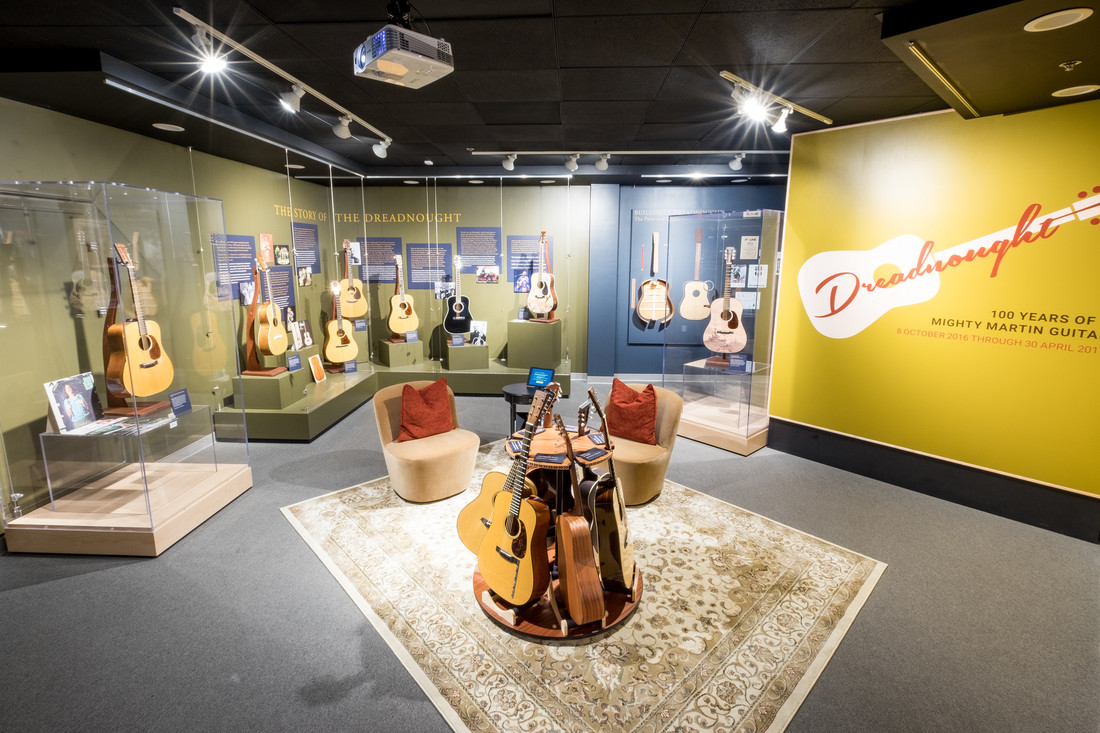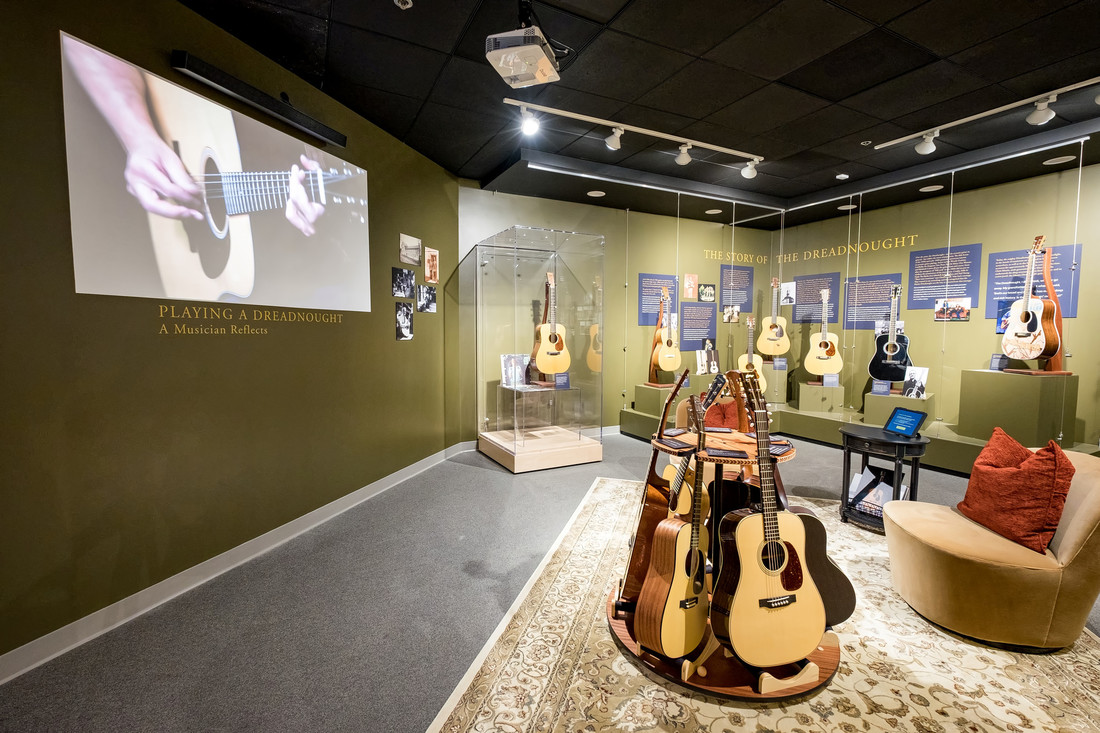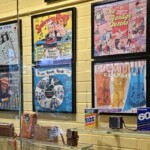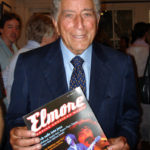
By Meghan Roos
There once lived a Hawaiian musician named Major Kealakai who had a vision for what his guitar could sound like. Like all others making music in the early 1900s, Kealakai had access to an assortment of small-bodied “parlor guitars,” designed for use in small spaces. When Kealakai asked for a larger instrument in 1916, C.F. Martin & Company designed the Dreadnought, the first large-bodied acoustic guitar capable of producing the powerful sound Kealakai and his contemporaries sought. One century later, this is the instrument responsible for pushing the guitar to the front of the stage in popular music, the most in demand acoustic guitar model among professional and amateur musicians alike. In a new exhibit at the Museum of Making Music in Carlsbad, California, the Dreadnought’s story is told through detailed placards, guitars on loan from C.F. Martin & Company, a documentary narrated by Jeff Daniels and more, all on display through April 16th, 2017.
The Museum of Making Music packs a lot of history into its small space. Visitors reach The Dreadnought: 100 Years of a Mighty Martin Guitar after traveling through the instruments, phonographs, concert programs and posters that narrate the history of the music industry. Like the museum, this exhibit is narrative and interactive: placed in the center of the exhibit cases is a stand holding six guitars for visitors to inspect and play. Some strum away as photographs of James Taylor, Johnny Cash, Stephen Stills, Paul McCartney and others watch from the walls; others wander to the far corner of the exhibit where the 2016 documentary The Ballad of the Dreadnought is projected onto a wall.

The Dreadnought is iconic enough that most people don’t recognize it as a single model designed by a single company. It’s like a spoon or a picture frame; it’s been around long enough that we take its creation for granted and don’t think about the details. This is a testament to the instrument C.F. Martin & Company created– named for the British warship the HMS Dreadnought, the guitar is as durable and dependable as its creators could have hoped.
Curated by Museum of Making Music Executive Director, Carolyn Grant, and Director of the Martin Guitar Museum and Archives, Dick Boak, The Dreadnought has one main mission: sharing a story. “[C.F. Martin & Company] has a long history and legacy that’s interwoven with American music and culture.” Boak said. “We love to tell our story and keep building guitars that sound great.”
Grant was approached by Christian Frederick Martin IV– the current chairman and CEO of C.F. Martin & Company– last year about hosting the centennial exhibit. “It took me about half a millisecond to say yes,” Grant said. Grant and Boak began collaborating on the exhibit features and commentary shortly thereafter. “We want [the exhibit] to serve as an area where people can come in, sit down, grab a pillow, play a guitar,” Grant said. “It doesn’t take much of a spark to ignite a lifetime of music making or music appreciation. We are here at the Museum of Making Music to inspire that spark.”

From Kealakai’s initial request to Gene Autry’s popularization of the guitar in the 1930s and the following insurgence of Dreadnought players, the exhibit catalogs the instrument’s transformative moments. “One of the key things that happened is that the microphone was invented,” Boak said. “Radio and stage performances allowed the guitar to come from the back of the stage up to the microphone. That started the singer/songwriter and guitarist movement that we’re still experiencing today. It rendered everything before it obsolete.”
When paired with new amplification technology, the Dreadnought’s resonating sound also gave musicians the chance to play acoustic sets in large venues. The days of reserving acoustic guitars for quiet, intimate settings were over. “Since that point, you could pick any musician’s name out of a hat. Everybody, anybody; the guitar’s who’s-who and the who’s-who of the music world from Hank Williams and Ernest Tubb to Elvis Presley, the Beatles, Crosby, Stills and Nash, Neil Young, Tom Petty, Johnny Cash, Willie Nelson. Everybody plays these guitars.”

Boak is C.F. Martin & Company’s in-house Dreadnought expert. He’s been involved in nearly every aspect of the company since he was hired as a guitar craftsman in 1976 and has built signature guitars for several of the music industry’s biggest names. He knows how to design an instrument to sound the way its owner envisions, and credits the Dreadnought with bringing the possibilities of acoustic sound to new levels. To drive this point home, the exhibit features “Building a Dreadnought: the Parts and Pieces,” a small wall panel that shows every last bit of a Dreadnought’s inner workings.
Forty years after Boak joined C.F. Martin & Company, the Dreadnought is still the company’s most popular instrument. “The Dreadnought is now the most copied acoustic guitar design in the world,” Boak said. “There are many people honoring us by producing their versions of our designs.” The Dreadnought is also one of the most recognizable guitar styles in production, found just as easily onstage at venues like Madison Square Garden as it is in the homes of children learning to play.
“There’s a purity about it,” Boak said. “The vibrations go right through your body. I don’t think it’ll ever go out of style.”
The Dreadnought opened with a reception featuring Boak and performances by John Batdorf and James Lee Stanley on October 7th, and will remain on display through April 16th, 2017. For more information head the the Museum of Making Music’s website.







Be the first to comment!